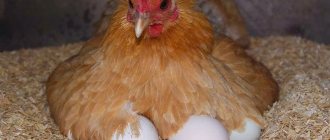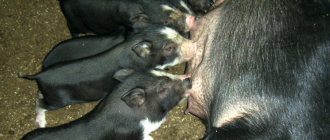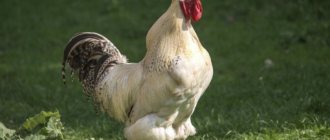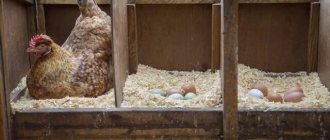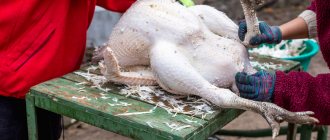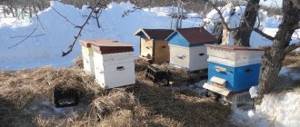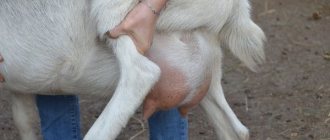Solution
The tips below are also effective in cases where chickens peck each other or a rooster.
When making your first attempts at pterophagy, you should check the housing and feeding conditions. Buy a vitamin complex for the chickens and, if necessary, adjust the menu and living conditions.
In case this does not help, domestic farmers have created several good ways to solve the problem:
Chickens often peck at each other, but this rarely results in plucked bald patches and bloody wounds. If pecking reaches such an extent, it is called pterophagy. This is not a disease, but several factors can lead to this.
Chickens have a strict intra-flock hierarchy, where each individual has its own place in the chicken “table of ranks”. The lowest-ranking individuals are ostracized, pecked and slaughtered to death, and such persecution is always started by high-ranking hens or roosters.
If the situation does not reach such extremes, a low-ranking chicken may not be allowed access to water and food, causing it to begin to lose weight and waste away. Therefore, if the same bird always stays away from others, is the last to approach food and water, if it is pecked and driven away from the feeders, then measures must be taken without waiting for the pecking.
The outcasts are often young or new birds. Therefore, restocking should be carried out carefully and measures should be taken at the first sign that old chickens are pecking new ones.
Poor nutrition
Chickens can become cannibals and peck their own kind in order to get the vitamins and minerals they need if they do not receive enough from their diet. This reason is especially relevant for intensively laying, gaining weight or molting birds, since their bodies require more calcium and protein.
Improper nutrition leads to a lack of necessary substances if you feed chickens with low-quality feed or mash that does not contain proteins and calcium.
In addition to cannibalism, its signs are:
- Chickens eating feathers;
- Egg pecking;
- Very thin egg shells.
The problem can be corrected by adding more sources of protein and calcium to the diet: fish broth, whey and crushed shells.
Stressful conditions of detention
Chickens can also peck at each other due to flaws in their keeping:
- Lighting. Too bright light is harmful for adult birds - it provokes aggression;
- Closeness. When there is a lot of crowding, chickens instinctively begin to kill the weak ones to make room;
- Increased humidity and temperature. They cause stress in chickens, which leads to increased aggression.
If eliminating these causes does not help, you need to resort to other measures.
If you follow the conditions of detention and carefully monitor your pets, you can avoid this situation and prevent pecking. But if this doesn’t help, then just use the tips.
Makarov Ivan Vasilievich
Hereditary poultry farmer, owner of a poultry farm, graduated from St. Petersburg State Agrarian University with honors, author of articles in specialized publications
Most common questions
Chickens not only peck each other, sometimes unique situations arise that require an individual approach.
Rooster pecks hen on the head
There may be several reasons why a rooster pecks a hen on the head. Most likely, this is a weak or new bird that is not accepted by the flock and repeats the action of the leader. If traditional methods do not help, you can try the next option. The neck, head, and crest of a regularly suffering bird are smeared with chloramphenicol ointment, which is very bitter, but completely safe. Because of this taste, aggressors quickly lose interest in the victim.
Rooster pecks hen on the head
The rooster beats the same hen
This chicken behavior can be due to two reasons:
- The chicken is sick.
- The rooster wants to persuade a particular individual to have sexual intercourse.
Initially, you need to carefully begin to observe the behavior of the chicken; if suspicions of health problems are confirmed, then contact a veterinarian
It is important to place the injured chicken in a separate place; after some time after healing, they try to return it to the general mass
Chickens chasing a rooster
If hens start chasing a rooster after living together, then measures should be taken immediately. First of all, wounds are healed with the help of antiseptics. Chickens distinguish the color red very well and are eager to taste it. Most likely, the rooster had a wound and the birds reacted to the blood. Therefore, all wounds should be masked using antiseptics, such as brilliant green.
Note! The damaged areas are treated with an ointment that is safe for the health of the birds, and the rooster is sent back to the chicken coop
Chickens peck at a man
Sometimes a rooster not only pecks his neighbors in the chicken coop, but also people
It is important to start reacting immediately. You can try to appease an aggressive bird with treats, but this does not always work.
The most effective way is to organize aviaries for birds so that they do not wander on their own. True, aggression will not disappear.
An effective way is to use plastic glasses. They will make the bird confused, and it will have no time for people. You can use the fasting method. The aggressor is put in a separate cage and is not visited for about 2 days
It is important to leave water to prevent depletion. If isolation is carried out immediately after the attack, the bird will quickly realize its mistake
In conclusion, I would like to note that cannibalism among birds is a fairly common phenomenon that should be combated. The best option is to eliminate, if possible, the causes that contribute to the occurrence of cannibalism.
It is no secret that the poultry community has its own specific rules. Sometimes birds behave aggressively towards humans, but more often towards each other. Why a rooster pecks a hen, experts give varied answers, each case is individual. You also need to know how to deal with it.
Causes of rooster pecking
If in a chicken coop there is aggression from hens towards the rooster, accompanied by pecking at the head and other parts of the body, it is worth understanding the original basis for this behavior. Below are the main reasons for this phenomenon in a chicken flock.
Lack of nutrients in food
Many farmers feed chickens with compound feed, which should include all the necessary nutrients, but in practice it often does not meet the standards.
Improper conditions for keeping birds
With proper arrangement of the poultry house, hens and roosters will live in peace and harmony. Birds begin to conflict for the following reasons:
- if the room for their living is very cramped;
- they may be unnerved by excessive noise;
- insufficient or excessive lighting.
In winter, pecking occurs most often , since the birds are in a cramped room and can peck simply out of boredom.
Too much light in the coop can cause birds to see the veins in the skin of chickens and roosters and will peck at these areas, which can result in fatal wounds.
Excessive dry air in the poultry house can also be a cause of chicken aggression. Insufficient air humidity causes fragility of the feather cover, which the bird treats with a special secretion. The chicken presses its beak on the coccygeal gland, thereby damaging the skin, which will make other birds want to attack.
Established hierarchy in the chicken coop
The poultry house has its own rules and an established hierarchy. Usually the rooster acts as the head of the flock, keeping an eye on the hens. He makes sure everyone eats, goes out for a walk, and protects the flock from danger. But still, sometimes the rooster loses its position as leader. This can happen if the rooster’s authority has been shaken by the hens, for example, in a collision with a person when he defeated the leader of the chicken flock.
Causes of cannibalism in chickens
Let's try to figure out why chickens peck each other until they bleed. Prerequisites for such behavior may be:
- molting in progress;
- poor living conditions;
- malnutrition.
If you notice similar behavior in chickens, you can consider this a manifestation of cannibalism (pterophagy).
Often the first time you encounter pecking is during the seasonal molting period. If a bird has lesions on its skin as a result of feather loss, its relatives may first begin to peck at small wounds out of curiosity. But as soon as they feel the taste of blood, the birds, obeying instinct, will kill the individual to the end. If you do not intervene, the attacked chicken or rooster will receive a painful shock and may die. Starting from the head or tail, birds can leave only one skeleton of it in a few hours. In some individuals, pterophagy begins with pecking out their feathers. The poor conditions in which young birds live make the problem worse. Crowding, cramped cages and rooms create a stressful situation for them. Chickens are nervous and the opportunity to choose a victim and peck it is their only chance to be distracted and occupy their attention with something. As soon as one bird begins to peck another, other relatives immediately join it. At first, they pluck the feathers of the victim, then the turn comes to real pecking, which quickly leads to the death of the attacked chicken or rooster.
A lack of calcium, protein and sulfur in the body will certainly contribute to cannibalism in chickens. When there is an excess of protein, phosphorus and vitamin A, metabolism changes and this can also encourage chickens to peck each other. During the molting period, birds especially need vitamins; it is important to provide them with adequate nutrition.
The behavior of old individuals attacking young ones can be explained by competition for resources - this is a normal phenomenon that occurs in nature as a tool of natural selection. If, having established a hierarchy, experienced laying hens do not calm down, but continue to fight, this can also lead to the problem of cannibalism.
We also recommend reading:
Ideas for a warm chicken coop Chinese silky chickens are unique cuties Exotic breeds of chickens that lay colorful eggs Magic for everyone: how to hypnotize a chicken
Why do chickens peck the rooster? Most often this happens when a purchased young rooster is added to the flock, which the hens perceive as a competitor, a contender for power or an equal. It is better to do the opposite, placing the birds in the chicken coop one at a time after the rooster - then he can easily take the leading position.
What to do with a wounded bird
If a collision has already occurred and the cockerel or hen is seriously injured, this cannot be ignored. Timely measures must be taken to ensure that the victims recover.
First aid
The wounded bird must first be separated from aggressive flock members. Having isolated her from the aggressors, you should start treating the wounds. Typically, disinfectants are used for this - iodine, glycerin, brilliant green.
Treat bird wounds with iodine
Treatment of injured birds
Next, the injured bird is kept separately, using a special cage or blocking it with a partition. The injured pack member should be kept separately until complete recovery.
While the wounded bird is in isolation, it is necessary to find out the exact cause of the attack and eliminate it, otherwise pecking will continue, and this is dangerous because it can become a habit among chickens. Aggressive birds need to change their diet, adjust lighting and improve living conditions.
If, after the cockerel is fully restored, attacks from its relatives do not stop, the main instigators of conflicts must be punished. However, there are individuals for whom nothing helps, their aggression may be caused by character traits, in which case they need to be used for meat, otherwise peace will not be achieved in this poultry house.
Preventing pecking
Considering the reasons that hens become aggressive towards the rooster, you need to do everything possible to ensure that a peaceful atmosphere reigns in the chicken coop. To do this, you should take care of proper care of the chickens, focusing on the factors listed below.
Nutrition and diet
The first step is to balance the poultry diet; it must be nutritious and contain the necessary nutrients.
Read also: Chickens “Ga Dong Tao”
You can increase the protein level by adding the following products to your chickens' food:
- milk powder;
- soy products and meat and bone meal;
- introduction of special vitamin and mineral complexes into the diet;
- It is recommended to throw them limestone with small pebbles, which will facilitate digestion.
A rooster should eat bran, legumes, and cake, and it is very beneficial for laying hens to eat greens and grains. We must not forget about the amount of water consumed by birds: per individual there should be an average of 300 g of water.
Conditions of detention
To stop the pecking that has begun and prevent this unpleasant phenomenon, it is worth organizing suitable living conditions in your poultry house. To do this, it is necessary to take a number of measures:
Bird care
Chickens pecking and attacking a rooster is not the norm and has a number of possible causes. By knowing about them, you can take the necessary steps to avoid aggression in the coop and establish a calm, harmonious atmosphere in your chicken flock.
Why do old chickens peck new ones?
The reason for bullying, fighting and pecking in chickens is competition for resources as old as time: territory, food and seniority in the flock. The struggle for resources is the driving force of natural selection and evolution, that is, a normal natural phenomenon characteristic of both animals and humans (in more complex forms). As a result of this struggle, a clear hierarchy is established in the flock, in which each chicken has its own status. For example, larger and stronger chickens (usually older chickens) are the first to eat and the first to settle down in the chicken coop for the night. The new hens (less experienced and smaller) patiently wait their turn at the feeder and try to stay out of the way of the older hens. Often, at first, new chickens hide on higher perches from old chickens (see photo below, our new chickens hide from old ones on the roof of the feeder). This process is absolutely normal and does not require the intervention of the poultry farmer at this stage.
The problem arises if, having already established their seniority in the flock and their privileged status in the hierarchy, which no one disputes, the old hens continue to aggressively attack the young ones, causing them physical harm and not allowing them near the feeders. In domestic chickens, pecking and fighting lead to stress and a reduction in egg production. Chronically malnourished and deprived of water, a young chicken may simply die from dehydration and exhaustion; in chickens this develops very quickly, because with their low weight, as they say, they don’t need much. Often exhaustion and dehydration go unnoticed until the most critical moment due to the lush plumage of chickens. If a wound on the body of a chicken, which is subject to constant attacks, begins to bleed, then other chickens, attracted by the sight and taste of blood, will join in the attack and pecking, and the matter may end in cannibalism. Chickens are cannibal birds. Cannibalism in animals is the result of a long evolution and a completely natural phenomenon aimed at regulating numbers and generally surviving the population in unfavorable environmental conditions (which for chickens is an overcrowded chicken coop and limited access to food and water). Moreover, in nature, females are more prone to cannibalism, and cannibalism in chickens is more often directed at young animals of their own species. You shouldn’t blame chickens, they are just animals and they are not guided by reason, feelings and morals, but by instincts.
Of course, cannibalism is an extreme case of bullying among chickens, but any fights, feather plucking and pecking in the flock irritate the chickens themselves and greatly upset the owners. If you see that your hens are pecking another hen or each other, immediately and mercilessly stop this and ensure that the laying hens are kept in such conditions as to prevent future fights. How to do it?
Why do chickens peck the rooster?
Even the most experienced poultry keepers sometimes notice that hens and roosters are not so harmless. There is also a hierarchy in their bird “family”, and quarrels can arise. Typically, there are 10-12 laying hens per rooster. As a rule, he takes care of them and protects them, but sometimes the rooster allows himself to peck the hens or is in danger himself. If you notice that fights have started in the chicken coop, then it is worth finding out why the hens are pecking the roosters or vice versa, and immediately prevent pecking.
Why do chickens peck each other and pluck feathers?
Pecking in chickens can occur at any age. But most often, cannibalism is observed in two main age periods - during the change of down in chickens to primary plumage and before the start of egg-laying in young laying hens.
As a rule, pecking is preceded by pterophagy - this is an abnormal behavior when chickens pluck each other's feathers and eat them. It is often observed in young animals with a deficiency of protein, vitamins and minerals in the body during the period of active growth and feather change.
According to statistics, brown-feathered laying hens are less prone to cannibalism than white breeds of chickens. It was also noted that highly productive egg crosses have the greatest predisposition to pecking.
Causes of pecking in chickens
During the period of active growth, chickens have an increased need for protein and vitamins. Individuals peck off fallen feathers during juvenile (primary) molting, and the most aggressive ones pinch them from weaker relatives and peck their toes.
If no measures are taken to combat cannibalism at this stage, the condition may develop into pathological behavior.
Cannibalism and pterophagy in adult laying hens
The main reasons why chickens pluck feathers from each other, eat them, or even peck their relatives until they bleed:
- Deficiency of vitamins, amino acids and microelements . An unbalanced diet leads to a lack of certain substances in the bird’s body. Laying hens react especially acutely to a deficiency of methionine, cysteine, calcium, phosphorus, sulfur, sodium, and vitamins A and D.
- Protein overfeeding or starvation . An imbalance in protein always leads to pecking in mass laying hens. A sudden introduction of meat products into the diet followed by a sudden withdrawal from feeding can lead to a problem.
- Frequent diet changes . They cause an imbalance of nutrients. First, the chickens peck each other's feathers, and then beat their relatives until they bleed.
- Excessive lighting in the coop . To increase egg production in winter, many poultry farmers stimulate egg laying in laying hens by increasing the length of daylight hours. With a sharp increase in the duration of lighting, chickens become stressed, which can result in pecking. Excessively bright light negatively affects the bird's nervous system. As a result, chickens peck at each other and eat eggs.
- Tight fit . In crowded or cage housing, chickens often eat each other's feathers. This behavior is caused by stress or boredom due to lack of exercise. By plucking each other's feathers, birds injure the skin, which in turn causes them to peck until they bleed.
- Skin parasites . Ticks, fleas, and feather eaters cause itching in birds, worsen the condition of the feather cover, and cause vitamin deficiency and anemia. Infected individuals begin to pluck their feathers. The activity of parasites also becomes a consequence of baldness in chickens.
- Unsanitary conditions of detention . Increased dampness in the chicken coop and dirt cause the appearance of external parasites, which, as described above, often cause pecking.
- Lack of drinking water is one of the reasons why chickens peck each other until they bleed.
- Inflammation and prolapse of the oviduct (cloacitis) . The pathology is often accompanied by bleeding in the posterior region of the tail. A sick bird attracts attention. If a sick individual is not removed from the chicken coop in time, this can lead to massive pecking.
- Feeding contaminated grain feed with mycotoxins . Poor nutrition provokes allergic dermatitis, which causes itching of the extremities and, as a result, pecking of the paws.
- Establishing a hierarchy in the herd . Often observed when young animals are added to an old herd. If a chicken pecks at one of the weaker individuals, then you should take a closer look at the “victim” - perhaps she is sick.
It is not uncommon for chickens to peck at a rooster during cannibalism. In this case, the male, as a rule, does not touch the females.
Lack of nutrients in food
Many poultry farmers keep chickens and roosters on feed. Of course, ideally, compound feed should contain all the necessary and beneficial substances, but most often such feed does not meet the standards. In this case, you should feed the chickens yourself. The food must contain minerals. To do this, you can use special additives or simply add chalk, fishmeal and small eggshells. It is recommended to give them limestone with small stones, which facilitate the chickens' digestion.
The rooster's diet should be rich and have a good effect on its reproductive system. The rooster's diet should include bran, cake, and legumes. All this is enriched with vitamins and nutrients. It is imperative to control the amount of water. One rooster needs 300 g of water per day.
For laying hens, the diet should include not only mixed feed, but also greens, vegetables, grains and mineral and vitamin complementary foods.
Why does a rooster in a bird harem peck at a hen?
It is no secret that the poultry community has its own specific rules.
Sometimes birds behave aggressively towards humans, but more often towards each other. Why a rooster pecks a hen, experts give varied answers, each case is individual. You also need to know how to deal with it. The chicken yard, as a rule, lives according to the principle of hierarchy. Sometimes conflicts and disputes break out between individuals. Typically, one rooster controls and cares for about 10 or 12 females. His so-called responsibilities include guardianship, protection of laying hens, and, one might say, raising chickens.
Fights can be caused by crowded conditions in the poultry house, too bright lighting, or almost complete absence of it, noise and sharp extraneous sounds in the room where the birds are kept. Uncomfortability and an uncomfortable state can provoke fights between individuals of either sex.
If the rooster starts pecking at one of the females, perhaps she is the weakest in the flock, or does not obey the rooster and does not follow his instructions. Moreover, other female birds can join him.
Reasons for pecking
In most cases, cannibalism in poultry appears at 3–4 weeks of age. Less commonly, a similar condition is observed in adult chickens. As a rule, such a non-standard reaction in relation to their relatives initially occurs in physically strong, viable specimens, after which it spreads to the rest. Birds injure their relatives, peck out the cloaca, intestines, and get to the insides. A pecked herd quickly dies. Injured individuals become unviable.
After the young, adult chicken flock has chosen an object as a victim, within a matter of hours the birds attack, chase the chicken, get to the internal organs, peck out the eyes and intestines. You can often see chickens plucking each other's tails. Accordingly, the pecked bird dies. To stop this behavior in birds, it is very important to establish the root cause, since cannibalism is not a disease, but a reaction to external stimuli and negative factors. Why do chickens peck each other until they bleed?
Among the most common reasons that provoke cannibalism among chickens are:
- poor living conditions;
- non-compliance with zoohygienic standards;
- improper feeding during the juvenile period;
- lack of lighting, high humidity in poultry houses;
- violation of diet, sudden change in diet;
- overcrowding of poultry in chicken coops.
If chickens peck each other until they bleed, they are establishing rules of hierarchy. The bird fights for leadership and wins the best territory. As you know, in nature the strongest individuals survive. The inhabitants of the cells become more aggressive as they approach the light source (in the upper rooms).
It is worth noting that there are fewer cases of pecking among roosters than among hens. Scientists have noticed that pecking occurs less frequently among brown-colored egg hens than among white and meat varieties.
Poor living conditions
If the conditions of detention are violated or not observed, strong individuals begin to peck at weak ones. Dominant chicks strike the fingers, tail, back, tear out feathers in the tailbone area, and peck at the skin. Gradually, the weakened individuals are attacked by other inhabitants of the chicken coop. The sight of blood adds confidence, causes excitement, and gets the youngsters excited. This behavior of birds can lead to the death of the entire chicken population.
Pecking in chickens also occurs when there is a sudden change in the conditions in the premises where the birds are kept. Lack of lighting, breakdown of the ventilation system, high air humidity, failure of night lighting, excessive noise, and outside sounds in the chicken coop can provoke severe stress in chickens, which becomes one of the reasons for aggression among birds.
Important! A strong difference in day and night heating, a sharp change in temperature conditions can also cause aggression in birds towards their relatives.
It is worth noting that chickens have color vision, so chicks react sharply to the lack of lighting in chicken coops. If there is not enough light for the bird, a sharp change in the usual light regime can cause changes in behavior in birds, both young and adult chickens.
As already noted, crowding and lack of free space often provoke mortality in chicken coops and on private poultry farms. Chicks fight for space, winning territory from weaker individuals. Therefore, the more space allocated for birds in the chicken coop, the less risk that the chickens will start pecking each other. Therefore, in order not to provoke aggression among young animals, follow the rules for keeping poultry.
Poor diet, unbalanced feeding
Another most common reason why hens and chicks begin to injure each other is due to improper feeding. If the diet is not balanced, the body becomes deficient in nutrients necessary for growth and development. To replenish the balance of vitamins and minerals, chickens begin to peck at anything, including their fellows.
Most often, young animals suffer due to a lack of:
If the bird does not receive salts with the feed, the chickens feel worse, which can cause aggression. If your chicks begin to pluck each other's feathers, they are likely to be calcium deficient. At the age of one month, the chicks shed their down, exchanging it for feathers. If during a given period there is not a sufficient amount of proteins and amino acids in the food, the main signs of a lack of proteins are that the birds begin to pick up and eat feathers or pluck them directly from their fellow birds.
The manifestation of aggression in birds provokes a deficiency or, conversely, an excess of protein, therefore, if the chicks are fed exclusively with protein foods, the young animals will constantly injure each other.
Individuals whose diet consists primarily of whole grains rather than small grains are prone to pecking. Large grains are absorbed faster, but they are digested more slowly. The birds do not feel the necessary saturation and begin to attack, injuring their relatives. In addition, dominant adults often fight for food, winning it from the young.
